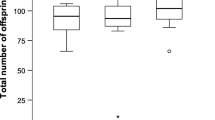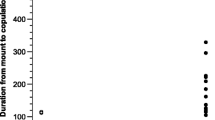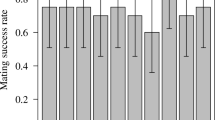Abstract
Males frequently mate multiply, but are there negative fitness consequences for their later mates? Potential costs include less sperm and less nutrition. In most hymenopterans, daughters, but not sons, are produced sexually. This mean that effects of being a later mate on sperm received versus on nutrients received should be distinguishable. If later mates receive less sperm, it should manifest as a reduction in daughter production, whereas a reduction in nutrients should affect production of both sexes. Any cost to being a later mate may in turn select for polyandry or for female choice of virgin males. Males of the parasitoid wasp Spalangia endius were presented with up to five females in succession. Offspring production was compared among first, third, and fifth females; and it did not differ. However, about half of fifth females had begun producing only sons by their tenth day, whereas first and third females rarely had. Despite the reduction in daughter production, even fifth females rarely remated. However, females tended to mate with virgin males rather than mated males when given a choice. This tendency was dependent on male, not female, behavior, but should benefit the female nevertheless. Sex ratios in this species are one male for every one and a half to three females. Thus, the number of times that males could mate before daughter production was reduced coincided roughly with the mean number of times that males likely mate in this species. Nevertheless, some females are likely to experience the cost of being a fifth female because of skewed mating success among males.





Similar content being viewed by others
References
Arnqvist G, Nilsson T (2000) The evolution of polyandry: multiple mating and female fitness in insects. Anim Behav 60:145–164
Bailey WJ, Nuhardiyati M (2005) Copulation, the dynamics of sperm transfer and female refractoriness in the leafhopper Balclutha incisa (Hemiptera: Cicadellidae: Deltocephalinae). Physiol Entomol 30:343–352
Barton Browne L, Smith PH, van Gerwen AC, Gillott C (1990) Quantitative aspects of the effect of mating on readiness to lay in the Australian sheep blowfly, Lucilia cuprina. J Ins Beh 3:637–646
Brandt Y, Allen JR (2004) Persistence of individually distinctive display patterns in fatigued side-blotched lizards (Uta stansburiana). Behav Ecol Sociobiol 55:257–265
Bressac C, Thi Khanh HD, Chevrier C (2009) Effects of age and repeated mating on male sperm supply and paternity in a parasitoid wasp. Entomol Exp Appl 130:207–213
Charnov EL (1982) The theory of sex allocation. Princeton University Press, Princeton
Damiens D, Boivin G (2005) Why do sperm-depleted parasitoid males continue to mate? Behav Ecol 17:138–143
Donaldson JS, Walter GH (1984) Sex ratios of Spalangia endius (Hymenoptera: Pteromalidae), in relation to current theory. Ecol Entomol 9:395–402
Edvardsson M, Hunt J, Moore PJ, Moore AJ (2008) Female agreement over male attractiveness is not affected by cost of mating with experienced males. Behav Ecol 19:854–859
Fischer CR, King BH (2008) Sexual inhibition in Spalangia endius males after mating and time for ejaculate replenishment. J Insect Behav 21:1–8
Foster SP, Ayers RH (1996) Multiple mating and its effects in the lightbrown apple moth, Epiphyas postvittana (Walker). J Insect Physiol 42:657–667
Gerling D, Legner EF (1968) Developmental history and reproduction of Spalangia cameroni, parasite of synanthropic flies. Ann Entomol Soc Am 61:1436–1443
Jimenez-Perez A, Wang Q (2004) Male remating behavior and its effect on female reproductive fitness in Cnephasia jactatana Walker (Lepidoptera: Tortricidae). J Insect Behav 17:685–694
Johnson JC, Ivy TM, Sakaluk SK (1999) Female remating propensity contingent on sexual cannibalism in sagebrush crickets, Cyphoderris strepitans: a mechanism of cryptic female choice. Behav Ecol 10:227–233
Kaitala A, Wiklund C (1995) Female mate choice and mating costs in the polyandrous butterfly Pieris napi (Lepidoptera: Pieridae). J Ins Beh 8:355–363
Kazmer DJ, Luck RF (1995) Field tests of the size-fitness hypothesis in the egg parasitoid Trichogramma pretiosum. Ecology 76:412–425
Kelly CD (2008) The interrelationships between resource-holding potential, resource-value and reproductive success in territorial males: how much variation can we explain? Behav Ecol Sociobiol 62:855–871
King BH (1988) Sex ratio manipulation in response to host size by the parasitoid wasp Spalangia cameroni: a laboratory study. Evolution 42:1190–1198
King BH (1991) No intersexual differences in host size and species usage in Spalangia endius (Hymenoptera: Pteromalidae). Great Lakes Entomol 24:17–20
King BH (2002) Breeding strategies in females of the parasitoid wasp Spalangia endius: effects of mating status and body size. J Insect Behav 15:181–193
King BH (2006) Mate location and the onset of sexual responsiveness in the parasitoid wasp Spalangia endius (Hymenoptera: Pteromalidae). Environ Entomol 35:1390–1395
King BH, Bressac C (2009) No fitness consequence of experimentally induced polyandry in a monandrous wasp. Behaviour (in press)
King BH, Fischer CR (2005) Males mate guard in absentia through extended effects of postcopulatory courtship in the parasitoid wasp Spalangia endius. J Ins Physiol 51:1340–1345
King BH, Saporito KB, Ellison JH, Bratzke RM (2005) Unattractiveness of mated females to males in the parasitoid wasp Spalangia endius. Behav Ecol Sociobiol 57:350–356
Lauwers K, van Dyck H (2006) The cost of mating with a non-virgin male in a monandrous butterfly: experimental evidence from the speckled wood, Pararge aegeria. Behav Ecol Sociobiol 60:69–76
Linklater JR, Wertheim B, Wigby S, Chapman T (2007) Ejaculate depletion patterns evolve in response to experimental manipulation of sex ratio in Drosophila melanogaster. Evolution 61:2027–2034
Luck N, Joly D (2005) Sexual selection and mating advantages in the giant sperm species, Drosophila bifurca. J Ins Sci 5:10
Marcotte M, Delisle J, McNeil JN (2007) Effects of different male remating intervals on the reproductive success of Choristoneura rosaceana males and females. J Insect Physiol 53:139–145
Markow TA, Quaid M, Kerr S (1978) Male mating experience and competitive courtship success in Drosophila melanogaster. Nature 276:821–822
Martel V, Boivin G (2007) Unequal distribution of local mating opportunities in an egg parasitoid. Ecol Entomol 32:393–398
McNamara KB, Jones TM, Elgar MA (2007) No cost of male mating experience on female reproductive success in the almond moth, Cadra cautella (Lepidoptera; Pyralidae). Behav Ecol Sociobiol 61:1177–1184
Montrose VT, Harris WE, Moore PJ (2004) Sexual conflict and cooperation under naturally occurring male enforced monogamy. J Evol Biol 17:443–452
Nadel H, Luck R (1985) Span of female emergence and male sperm depletion in the female-biased, quasi-gregarious parasitoid, Pachycrepoideus vindemiae. Ann Entomol Soc Am 78:410–414
Nakatsuru K, Kramer DL (1982) Is sperm cheap? Limited male fertility and female choice in the lemon tetra (Pisces, Characidae). Science 216:753–755
Napoleon ME, King BH (1999) Offspring sex ratio response to host size in the parasitoid wasp Spalangia endius. Behav Ecol Sociobiol 46:325–332
Nsubuga AM, Robbins MM, Boesch C, Vigilant L (2008) Patterns of paternity and group fission in wild multimale mountain gorilla groups. Amer J Phys Anthropol 135:263–274
Perez-Staples D, Aluja M, Macias-Ordonez R, Sivinski J (2008) Reproductive trade-offs from mating with a successful male: the case of the tephritid fly Anastrepha obliqua. Behav Ecol Sociobiol 62:1333–1340
Ridley M (1993) Clutch size and mating frequency in parasitic Hymenoptera. Am Nat 142:893–910
Rönn JL, Katvala M, Arnqvist G (2008) Interspecific variation in ejaculate allocation and associated effects on female fitness in seed beetles. J Evol Biol 21:461–470
Rueda LM, Axtell RC (1985) Guide to common species of pupal parasites (Hymenoptera: Pteromalidae) of the house fly and other muscoid flies associated with poultry and livestock manure, Technical Bulletin 278. North Carolina Agricultural Research Service, North Carolina State University
Ruther J, Matschke M, Garbe L-A, Steiner S (2009) Quantity matters: male sex pheromone signals mate quality in the parasitic wasp Nasonia vitripennis. Proc Roy Soc B 276:3303–3310
Savalli UM, Fox CW (1999) The effect of male mating history on paternal investment, fecundity and female remating in the seed beetle Callosobruchus maculatus. Funct Ecol 13:169–177
Schlaepfer MA, McNeil JN (2000) Are virgin male lepidopterans more successful in mate acquisition than previously mated individuals: a study of the European corn borer Ostrinia nubilalis (Lepidoptera: Pyralidae). Can J Zool 78:2045–2050
Stein AC, Uy JAC (2006) Plumage brightness predicts male mating success in the lekking golden-collared manakin, Manacus vitellinus. Behav Ecol 17:41–47
Steiner S, Ruther J (2009) How important is sex for females of a haplodiploid species under local mate competition? Behav Ecol 20:570–574
Steiner S, Henrich N, Ruther J (2008) Mating with sperm-depleted males does not increase female mating frequency in the parasitoid Lariophagus distinguendus. Entomol Exp Appl 126:131–137
Teal PEA, Gomez-Simuta Y, Proveaux AT (2000) Mating experience and juvenile hormone enhance sexual signaling and mating in male Caribbean fruit flies. Proc Natl Acad Sci U S A 97:3708–3712
Torres-Vila LM, Jennions MD (2005) Male mating history and female fecundity in the Lepidoptera: do male virgins make better partners? Behav Ecol Sociobiol 57:318–326
Trivers RL (1972) Parental investment and sexual selection. In: Campbell BG (ed) Sexual selection and the descent of man, 1871–1971. Aldine, Chicago, pp 136–179
Wedell N, Ritchie MG (2004) Male age, mating status and nuptial gift quality in a bushcricket. Anim Behav 67:1059–1065
van Alphen JJM, Bernstein C, Driessen G (2003) Information acquisition and time allocation in insect parasitoids. Trends Ecol Evol 18:81–87
Wolfner M (2002) The gifts that keep on giving: physiological functions and evolutionary dynamics of male seminal proteins in Drosophila. Heredity 88:85–93
Zar J (1999) Biostatistical analysis, 4th edn. Prentice Hall, Englewood Cliffs
Acknowledgements
Thanks to C. Geden for providing starter S. endius; to J. Niew, A. van Pelt, and A. Colletta for laboratory assistance; and to R. Hahin and R. King for feedback on the writing.
Author information
Authors and Affiliations
Corresponding author
Additional information
Communicated by L. Simmons
Rights and permissions
About this article
Cite this article
King, B.H., Fischer, C.R. Male mating history: effects on female sexual responsiveness and reproductive success in the parasitoid wasp Spalangia endius . Behav Ecol Sociobiol 64, 607–615 (2010). https://doi.org/10.1007/s00265-009-0878-3
Received:
Revised:
Accepted:
Published:
Issue Date:
DOI: https://doi.org/10.1007/s00265-009-0878-3




